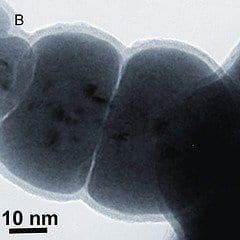
Wits PhD student finds a way to control the spin transport in networks of the smallest conductor known to man
Researchers at the University of the Witwatersrand have found ways to control the spin transport in networks of the smallest electrical conductor known to man.
By chemically attaching nano-particles of the rare earth element, gadolinium, to carbon nanotubes, the researchers have found that the electrical conductivity in the nanotubes can be increased by incorporating the spin properties of the gadolinium which arises from its magnetic nature. To put it plainly the presence of a magnet in an electron transfer media introduces another degree of freedom that enhances the electron transfer but only if tailored precisely.
Discovered in Japan in 1993, carbon nanotubes are the thinnest tubes in the universe, consisting of a cylinder of single carbon atoms. At the time of its discovery it was revolutionary, and it was expected that it could replace silicon in electronic circuits, such as microchips and computer hard drives.
“Carbon nanotubes are known for their ability to carry a high amount of electrical current and they are very strong. They are very thin but electrons can move very fast in them, with speeds of up to Gigahertz or Terahertz, and when coupled to nanomagnets they greatly extend the functionality of the carbon nanotubes, which is required to advance modern technology through the development of high speed spintronic devices,” says Siphephile Ncube, a PhD student at the Wits School of Physics and the lead author of the study. Her research was published in Scientific Reports on Wednesday (23 May 2018).
During her PhD, Ncube collaborated with a team of researchers from the University of the Witwatersrand, University of Johannesburg and the Paul Sabatier University in France. The researchers chemically attached gadolinium nanoparticles on the surface of the carbon nanotubes to test whether the magnetism increases or inhibits the transfer of electrons through the system. The measurements to interrogate the effect of magnetic nanoparticles on a network of multi-walled carbon nanotubes were carried out at the Nanoscale Transport Physics Laboratory (NSTPL) at Wits. This facility is dedicated to novel nano-electronics and it was initiated by the NRF Nanotechnology flagship programme.
“We found that the effect of the magnetic nano-particles is read off in the electronic transport of the nanotubes. Due to the presence of the magnet the electrons become spin polarised and the charge transfer is dependent on the magnetic state of the gadolinium. When the overall magnetic poles of the gadolinium are oppositely aligned, it causes higher resistance in the nanotubes and slows down the flows of electrons. When the magnetic poles are misaligned, it has a low resistance, and assists the electron transport,” says Ncube. This phenomenon is known as the Spin Valve Effect, which finds wide application in the development of hard disk drives used for data storage.
Ncube started her research on carbon nanotubes as a Master’s student at the Wits School of Physics in 2011, where she made single walled carbon nanotubes, by establishing a laser synthesis technique. Her work, which led to the publishing of various research articles in the field, was performed on instruments from the CSIR National Laser Centre Rental Pool Programme. She is also the first researcher in Africa to build an electronic device that can measure the electron transfer properties of the carbon nanotubes coupled to magnetic nanoparticles. She was funded by the DST-NRF Centre of Excellence in Strong Materials.
“Ncube’s research established the great potential of carbon nanotubes for ultra-fast switching device and magnetic memory applications, a realisation we have been working towards since the establishment of the NSTPL facility in 2009,” says Ncube’s PhD supervisor, Professor Somnath Bhattacharyya. “To date, modified nanotubes have demonstrated good spin transport for devices made from individual nanotubes. For the first time we have demonstrated spin mediated electron transport in a network of nanotubes without incorporation of magnetic leads.”
Read more: Making massive leaps in electronics at nano-scale
The Latest on: Nanoscale electronics
[google_news title=”” keyword=”nanoscale electronics” num_posts=”10″ blurb_length=”0″ show_thumb=”left”]
via Google News
The Latest on: Nanoscale electronics
- Georgia Tech group create world’s first graphene-based semiconductoron April 26, 2024 at 10:13 am
A group of researchers at the Georgia Institute of Technology (Georgia Tech) have created the world’s first functional semiconductor made from graphene, a development that could lead to advanced ...
- Automotive Electronicson April 23, 2024 at 5:00 pm
Recom has created a chassis-mount isolated dc-dc converter for nominal battery voltages from 24 to 90V. Called RMOD360-UW, it can deliver full power continuously with inputs between 27 and 106V, as ...
- Nanocircuitry: Miniaturizing Electronics to the Nanoscaleon April 20, 2024 at 12:50 pm
such as flexible electronics, wearable devices, and the Internet of Things (IoT), will open up new possibilities for smart and connected systems that can sense, process, and communicate information at ...
- Atom-by-atom: Imaging structural transformations in 2D materialson April 17, 2024 at 2:36 pm
Silicon-based electronics are approaching their physical limitations and new materials are needed to keep up with current technological demands. Two-dimensional (2D) materials have a rich array of ...
- Atom-by-atom: Imaging structural transformations in 2D materialson April 16, 2024 at 5:01 pm
Silicon-based electronics are approaching their physical ... in turn, affects both its nanoscale and microscopic behavior." The structure and properties of 2D multilayers are often highly ...
- Quantum electronics: Charge travels like light in bilayer grapheneon April 16, 2024 at 11:13 am
An international research team has demonstrated experimentally that electrons in naturally occurring double-layer graphene move like particles without any mass, in the same way that light travels.
- Nanoscale Movies Shed Light on One Barrier to a Clean Energy Futureon April 9, 2024 at 5:00 pm
Using nanoscale imaging techniques, Duke researchers are trying to understand why these catalysts break down and lose activity over time. Credit: Avery Vigil, Duke chemistry Part of the trouble is ...
- Tongfang Guoxin Electronicson April 3, 2024 at 5:00 pm
Tongfang Guoxin Electronics Co., Ltd. is engaged in the electronic components industry. It focuses on resonator, oscillator and capacitor. Its business scope includes manufacturing and sales of ...
- Molecular Electronics: Building Circuits at the Nanoscaleon April 3, 2024 at 2:36 pm
Molecular electronics is a branch of nanotechnology that focuses on using individual molecules or nanoscale molecular structures as electronic components to create miniaturized circuits and devices.
via Bing News










